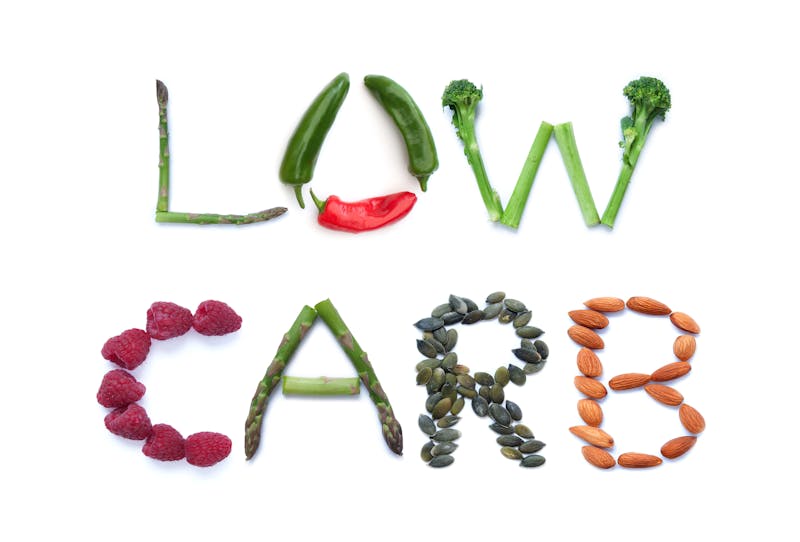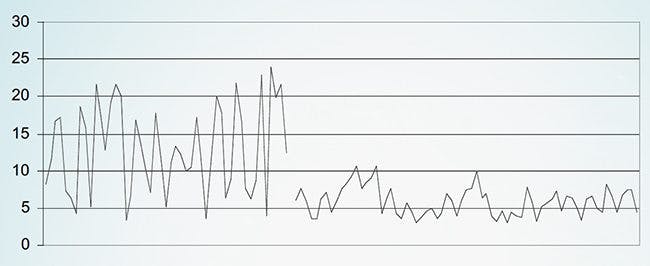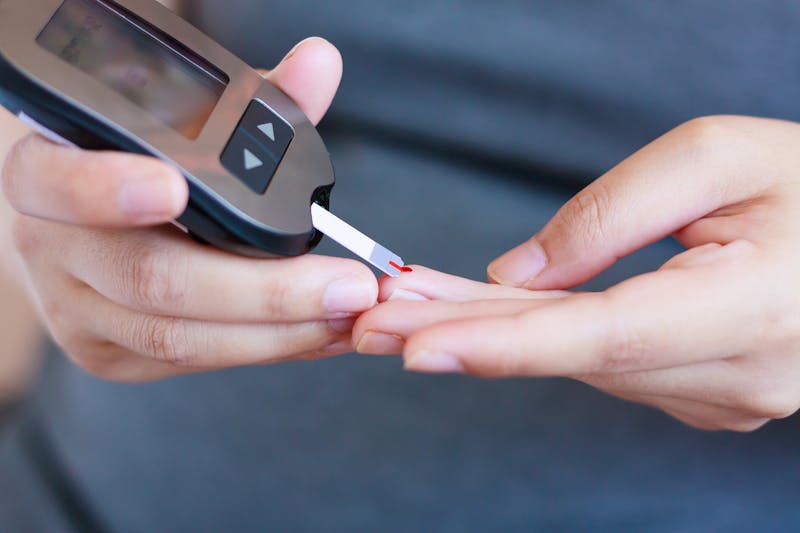Low Carb Diet and Diabetes Type 1
What are the risks of type 1 diabetes?
People with type 1 diabetes are at increased risk for a number of health issues, including heart disease, kidney disease, loss of vision, nerve damage and amputations.7
Importantly, these risks are linked to having high blood glucose levels, not simply having diabetes.
The American Diabetes Association has set the following blood sugar targets for people with diabetes who are otherwise healthy:
- Fasting blood glucose: 80-130 mg/dL (4.4 – 7.2 mmol/L)
- 2-hour postprandial (post-meal) blood glucose: less than 180 mg/dL (10 mmol/L)
- HbA1c: less than 7% (53 mmol/mol)
These numbers are quite a bit higher than what are considered healthy values for people without diabetes. Healthy people typically have fasting blood glucose levels below 100 mg/dL (5.5 mmol/L) and rarely experience blood glucose above 140 mg/dL (7.8 mmol/L) after eating.8
Additionally, a normal HbA1c is considered 5.7% (39 mmol/mol) or less.
However, the DCCT trial, which followed more than 1,400 people with type 1 diabetes for nine years, demonstrated that maintaining an HbA1c level of 7% (53 mmol/mol) or less was associated with a low risk of diabetes complications.9
But achieving very tight diabetes control in the DCCT trial was linked to an increased risk of hypoglycemic episodes. Clearly, at least part of the reasoning behind ADA's more generous targets for blood sugar and HbA1c is to avoid dangerous lows.
However, this assumes that the only way to reduce blood glucose is by giving more insulin. Yet if you are eating a low-carb diet to manage your diabetes, you will need less insulin, blunting the concern about increased hypoglycemia with more intensive glucose control. In fact, research suggests that a low-carb approach may potentially reduce the risk of hypoglycemia.10
Carb counting vs. low carb for type 1 diabetes
Prior to the discovery of insulin in 1921, many doctors placed their patients with diabetes on very-low-carb diets because they recognized that carbs raise blood glucose much more than does protein or fat.11 While this wasn't sufficient to manage type 1 diabetes, it did help to prevent extreme carb-related spikes.
The advent of injectable insulin allowed those with type 1 diabetes to eat carbohydrate without dramatically raising their blood sugar. However, even with insulin, controlling blood glucose levels can be a major challenge for them.
Today, diabetes educators often tell people with type 1 diabetes that they simply need to take insulin to match the amount of carbs they eat at each meal. In fact, many people who use ICRs have repeatedly heard, "You can eat whatever you like as long as you take the right dose of insulin."
However, there are several issues with this approach, including:
- Mistakes with carb estimation. In one study, the carb content of many foods was frequently overestimated or underestimated by children with type 1 diabetes and their parents – as well as by doctors and dietitians.12 This risks too much or too little insulin being given.
- No differentiation between types of carbs. Slowly digested carbs (such as vegetables) can raise blood sugar less and more gradually than rapidly digested carbs (like white bread).13
- Does not account for macronutrient composition of meal. Studies in people with type 1 diabetes have clearly shown that the amount of fat and protein in a meal will affect post-meal blood sugars. Specifically, fat is known to blunt the blood glucose rise in the first 2-3 hours and delay the peak glucose level due to delayed gastric emptying. While eating significant amounts of protein without carbs will not affect blood sugars, protein eaten with carbs will result in a higher peak blood glucose than that same amount of carbs without protein.14
- Does not take insulin absorption variability into account. Researchers have shown that the amount of insulin absorbed from an injection may vary by as much as 25% in the same person.15
For many people with type 1 diabetes, eating high-carb foods and taking large doses of insulin can cause blood sugar levels to resemble a rollercoaster rather than remaining within a narrow range.
In his book, Dr. Bernstein's Diabetes Solution, Dr. Richard K. Bernstein explains that eating very small amounts of slowly-digested carbs and taking very small doses of insulin leads to more predictable results and essentially normal blood sugar levels. He calls this "The Law of Small Numbers."
This makes a lot of sense, doesn't it? Let's say you estimate that a meal of meat and broccoli contains 25% fewer carbs than it actually has (for example, you estimate the meal to have 8 grams of carbs but it actually has 10 grams). You take a dose of insulin that would cover 8 grams of carbs, so you have only 2 grams of carbs that is not covered. Your blood glucose would rise only slightly more than if you had been able to exactly match your carb intake and insulin dosage.
Underestimating the carb content of a high-carb meal by 25% can lead to a very different outcome. Many people would consider meat, broccoli, potatoes, milk, and fruit a "healthy" diabetic meal. However, if you take a dose of insulin to cover an estimated 60 grams of carbs rather than the 80 grams this meal actually contains, you're likely to experience high blood glucose.
Overestimating the carb content of a high-carb meal creates a more urgent concern. Taking significantly more insulin than needed for a high-carb meal may result in hypoglycemia – dangerously low blood glucose that requires immediate treatment to prevent potential loss of consciousness.

Research supporting low carb for type 1 diabetes
Carb restriction for diabetes has mainly been studied in people with type 2 diabetes. However, results from the few studies that have tested this approach in people with type 1 diabetes demonstrate that it can be very effective for them as well:
- In 2016, a small randomized, controlled trial (RCT) found that people with type 1 diabetes who limited carbs to 75-100 grams per day for 12 weeks had significant reductions in HbA1c and blood glucose levels compared to those who practiced standard carb counting. Additionally, those who were overweight showed a non-statistically significant trend toward weight loss (11 pounds or 5kg).16
- In 2019, another small 12-week RCT showed that when 10 people with type 1 diabetes consumed fewer than 100 grams of carbs per day for 12 weeks, they achieved more stable blood sugar levels and had fewer episodes of low blood sugar than when they ate 250 grams of carbs per day. What's more, they lost about 5 pounds (2 kg) during the low-carb phase and gained almost 6 pounds (2.6 kg) during the high-carb phase.17
- In 2017, a shorter RCT found that people with type 1 who ate fewer than 50 grams of carbs per day for 1 week experienced more stable blood sugar control and fewer hypoglycemic episodes than they did during a week of eating 250 grams of carbs and the same number of calories per day.18
- In 2018, a group of doctors and researchers published results from a survey completed by 316 people with type 1 diabetes or parents of children with type 1 diabetes who consumed roughly 30 grams of carbs per day. The group reported exceptional blood glucose control with infrequent hypoglycemic episodes and an average HbA1c of 5.67% (39 mmol/mol).19
- In 2005, Swedish physicians published the results of an educational program for their type 1 diabetes patients that involved consuming 70-90 grams of carbs per day. They reported significant improvements in HbA1c levels, reduction in insulin dosages, and much more stable blood sugar levels throughout the day. One of the most impressive findings was a 94% decrease in hypoglycemic episodes after 3 months and an 82% decrease at 12 months.20

Blood sugar before and after starting a low-carb diet [ref]
- In 2011, the same doctors reported that the patients in their program who remained consistently low-carb maintained excellent blood sugar control with an average decrease in HbA1c of 1.8% after four years.21
Low carb and type 1 diabetes
How many carbs should someone with type 1 diabetes eat every day?
The short answer is that optimal daily carb intake varies among people with type 1 diabetes. As shown in the studies above, restricting carbs to fewer than 100 grams daily is often sufficient to improve blood sugar control and reduce the risk of severe hypoglycemia.
However, a very-low-carb approach (less than 30 grams per day) will require the least amount of insulin, possibly resulting in even more predictable blood sugar control and a greater likelihood of remaining within the healthy range throughout the day and night.
How people with type 1 diabetes can safely achieve great blood sugar control with low carb
People with type 1 diabetes who want to start eating low carb should ideally work with a doctor, nurse, dietitian or other health professional who specializes in diabetes and understands carb restriction.
This is because, in addition to decreasing the amount of insulin you take to cover carbs, you may need to make other adjustments, such as reducing your basal insulin dosage. Although the principles of management apply to everyone, you will need to assess the effects of a low-carb diet on your body chemistry. The best and safest approach is one that includes frequent testing, keeping detailed records, and evaluating your results.
For people who use an ICR to calculate their mealtime insulin doses, it is easy to manage a low-carb diet because the ratio will remain the same. So as you eat fewer carbohydrates, you will naturally inject less insulin.
Some overweight people will lose weight with a low-carb diet and become more insulin sensitive. If this occurs, it may be necessary to reduce the ICR, and probably also the basal insulin doses.22 For this reason, regular monitoring of blood glucose levels is important.
Protein may also need to be accounted for when calculating insulin dosage at mealtimes. Studies show that adding protein to a meal that contains carbohydrate will contribute to a higher peak glucose level.23 Although there is some research suggesting that protein in the absence or near-absence of carbs can raise blood sugar, more recent evidence does not support the idea that carb-free intake of protein contributes meaningfully to blood sugar levels.24
Failing to account for protein may result in excellent blood glucose levels an hour or so after a meal but higher levels several hours later.25
As with carbs, insulin dosing for protein intake varies from person to person, and determining your own body's needs will take some experimentation. If you underestimate the amount of insulin needed at a meal, the higher post-meal blood glucose can be managed by taking a correction dose of insulin at the next meal.
Alternatively, short-acting insulins (regular insulin) can be used with high-protein meals. These insulins have a slower onset of action than rapid-acting insulin analogs (such as aspart, lispro, and glulisine).
In one of his Diabetes University videos, Dr. Bernstein provides an excellent discussion about how to cover protein with insulin.
Additionally, his books and online resources provide more in-depth and individualized guidance for those who have type 1 diabetes and want to transition to a low-carb lifestyle safely.
Learn more about insulin dosage on a low-carb diet

Addressing concerns about carb restriction for type 1 diabetes
The most common concerns about carb-restricted diets for people with type 1 diabetes are that they are too difficult to maintain, may cause diabetic ketoacidosis (see below), and may increase the likelihood of hypoglycemia.
Sustainability
Carbohydrate restriction is entirely doable for people with type 1 diabetes. A very-low-carb diet maybe too restrictive for some people, who may prefer to eat a more liberal low-carb diet long term.
In addition to Dr. Bernstein, there are many medical and nutrition professionals with type 1 diabetes who have been following a low-carb approach for years with impressive, often life-changing results. Here are just a few who have shared their stories:
- Dr. Ian Lake
- Dr. Ali Lawati
- Dr. Wendy Pogelzelski
- Dr. Troy Stapleton
- Hanna Boethius
- Andrew Koutnik
- Dr. Keith Runyan
- Zein Gajraj
You can read about more success stories here!
Nutritional ketosis vs. ketoacidosis
Like others who follow very-low-carb diets, people with type 1 diabetes often go into ketosis. However, it's important to distinguish between diabetic ketoacidosis (DKA) and nutritional ketosis. DKA is an urgent medical condition in which there is insufficient insulin, usually leading to extreme elevations in blood glucose and blood ketone levels. In addition, a number of other metabolic changes occur that cause dehydration and severe illness.
By contrast, nutritional ketosis is a normal physiological state in which ketone levels are moderate (less than 3 mmol/l), with normal insulin and blood glucose levels.
As long as people with type 1 diabetes monitor their blood glucose levels regularly and take insulin as required, being in nutritional ketosis does not appear to increase the risk of DKA.26
Acute illness and ketoacidosis
Note also that the need for insulin – regardless of which foods you eat – increases with acute illness. For example, it is not uncommon for ketoacidosis to occur in connection with stomach illness, during which you don't eat and therefore may forget to take your insulin.
The same applies if you eat a low-carb diet. If you normally take low doses it isextremely important to understand that you will need more insulin during periods of illness. Failing to increase insulin when ill may confer the greatest risk with low-carbohydrate diets and reduced insulin doses.
Hypoglycemia
Fears of hypoglycemia often stem from results of the DCCT study, which found that, although tighter glycemic control helped reduce the risk of developing diabetes complications, it also increased the incidence of hypoglycemia.27
However, in that study, people were dosing insulin more aggressively, in order to achieve tight blood glucose targets.
Carb restriction enables people with type 1 diabetes to get the benefit of excellent blood glucose control without taking large quantities of insulin.
As reported by the hundreds of people with type 1 diabetes who have shared their stories – and as several studies discussed above have confirmed – the severity and frequency of hypoglycemic events can decrease considerably after transitioning to a low-carb diet (provided that insulin doses are reduced appropriately).
Specific advice for low-carb eating in type 1 diabetes
Total carbs vs. net carbs
At Diet Doctor, we generally recommend counting only the digestible (net) carbs in whole foods. Dr. Bernstein recommends that people with type 1 diabetes count some or all of the fiber, as high-fiber foods may distend the stomach and trigger the release of hormones that can raise blood sugar. 28 It is important to be aware that there are no published studies that have discussed this effect. However, some people with type 1 diabetes have confirmed that counting at least a portion of fiber in foods works best when calculating insulin dosages.
Eat more protein and healthy fat
Many people with type 1 diabetes are not overweight, so for them it is important to ensure they eat enough calories. If you cut way back on carbs, you'll very likely need to increase your intake of other macronutrients, such as protein and healthy fats. Protein is found in animal foods: meat, fish, eggs, and dairy products. It is also found in plants, including: beans, lentils, peas and nuts.
Protein provides essential amino acids, helps build and maintain muscle, and is involved in creating hormones, among other functions. It is an extremely important nutrient and one that shouldn't be skimped on, so use our target protein ranges chart to make sure you're getting enough.
In recent years, dietary fat has received criticism for increasing the risk of heart disease. However many fats are recognized by everyone to be healthy, particularly unsaturated fats found in plants, oily fish and meat. Attitudes are also changing about saturated fats (found in dairy and meat), which are no longer always regarded as unhealthy.29
Eating good quality, minimally processed fat-containing foods can ensure you maintain a healthy calorie intake when using a low-carb approach.
Treat hypoglycemia appropriately

Although episodes of hypoglycemia can be minimized with a low-carb approach, occasional lows are inevitable for people with type 1 diabetes. Regardless of the type of diet you follow, fast-acting carbohydrate (such as glucose tablets) is required in order to raise blood glucose to a safe level.
However, if you are eating low carb, you are likely to have less insulin in the bloodstream and may find that following the standard recommendation to treat with 15 grams of fast-acting carbs increases your blood glucose too much. It may take some experimentation to determine the exact amount you need. Some people with type 1 diabetes who eat low carb report that taking a single glucose tablet (about 4 grams of carbs) is enough to quickly raise their blood sugar up to the healthy range.
All type 1 diabetes success stories
Low-carb type 1 diabetes support and resources
Information
Dr. Bernstein's Diabetes University
Dr. Bernstein's Diabetes Solution (Read several chapters of his book online)
Let Me Be 83
Take Control of Type 1 Diabetes (Book by Dr. David Cavan)30
Individualized guidance from type 1 health professionals
Ketogenic Diabetic Athlete (Dr. Keith Runyan)
SVV Nutrition (Sean Vander Veer, Registered Dietitian)
Kelly Schmidt Wellness (Kelly Schmidt, Registered Dietitian)
DiaVerge Diabetes (Lisa la Nasa, Certified Level 2 Diabetes Paraprofessional)
Community/Forum
TypeOneGrit Facebook group
Podcast and videos
Diet Doctor Podcast #37: Dr. Jake Kushner
Video: Dr. Jake Kushner: Low fat or low carb for type 1 diabetes?
Video: Managing type 1 diabetes with low carb with Dr. Katharine Morrison
Low carb: benefits and limitations
It cannot be overemphasized that many things besides food can affect blood glucose levels, including stress, illness, increased physical activity and even seemingly mild alterations in sleep. Most of these are difficult or even impossible to prevent. Therefore, the most important thing when it comes to managing type 1 diabetes is to understand how these things can affect your glucose control.
If it is something you can predict, such as planned increased activity, then you can make adjustments to your insulin dose. If not, then it is important to know how to respond to an unexpected low or high glucose reading. Frequent testing is key and makes it much easier to manage these effects.
Fortunately, a low-carb diet can help you avoid big changes in glucose levels related to food, and simplifies mealtime insulin dosing so that a huge piece of the diabetes puzzle is no longer an issue. This can significantly improve your overall diabetes control, reduce anxiety, and enhance your quality of life.
/ Franziska Spritzler, RD
Low Carb Diet and Diabetes Type 1
Source: https://www.dietdoctor.com/diabetes/type-1
0 Response to "Low Carb Diet and Diabetes Type 1"
Post a Comment